The days in Batumi are over too soon, but I am very much looking forward to going to Tbilissi and meeting Davit and his family, too. So I get up early to take a swim in the Black Sea in spite of the still grey skies. After a rich breakfast Christy instructs the taxi driver to safely put me on the bus to Tbilissi and that is what he does. Perched in seats as close to those in front as possible I see small stands selling pottery and traditional food along the roads. As the minibus speeds along the highway I fall asleep quite soon and only wake up when we take a break at a small motorway station where you can use the toilet, buy some homemade food or just stretch a little and sit on a terrace covered in wine, full of heavy grapes. When we approach the capital Davit texts me asking where I will get off. Oh, good, I didn't know there where different options! But I manage to find out in time and soon I find myself waiting for him close to one of the main entry stations, warding off taxi drivers.
It's been ten years since Davit was an exchange student in my neighborhood and studied in my brother's class in high school. It's so good to meet him again and to get to know his young family and friends. They all welcome me very warmly no matter if we have a common language or not. I find that hearing Georgian around me all the time (and not understanding more than maybe four words) doesn't give me a headache or has any of the exhausting effects I remember form earlier experiences of being immersed in a completely new language.
On the first night Davit takes me on a tour of especially old Tbilissi to give me a first impression of his hometown. I instantly like the city - and I instantly know that I'd never drive here myself with all the steep streets and fast paced traffic. We drive up to the fortress of Narikala and enjoy the view over the city with the river Mtkvari and a lot of old and new buildings. Like in Batumi, Misha, as they call former president Mikheil Saakashvili, made use of some opportunities to carry out some of his own ideas of creative architecture or have others decorate the capital with impressive new buildings like the Bridge of Peace by Italian architect Michele de Lucchi which was opened in 2010. Many people have mixed feelings about some parts of this modernization. For this bridge the slightly disrespectful nickname 'Always Ultra' was coined due to its resemblance to a ladies' pad...
Tbilissi seen from the Fortress Narikala
View from the other side of the river: Colorful water play close to the Bridge of Peace,
the Fortress Narikala illuminated in the background up the hill
During my stay I take some long walks around different parts of the city on my own (and managing to find my way back home by asking many helpful Georgians in a mix of various languages), but more often very well guided by Davit's mother whom I had already met in Germany many years ago. It is so great to see her again and get both knowledgeable tours of Tbilissi and good conversations about life in general. She also takes me out of town to the open air Ethnographic Museum with her daughter in law and little grandson. We enjoy the walk between traditional houses from various regions of Georgia and after that sit by the lake. As it is a week day it's not so crowded in the otherwise very popular destination for family outings.

On another day Davit and Nino take me out to Mtskheta which used to be the Georgian capital from the 3rd century BC to the 5th century AD. The Aragvi river joins the Mtkvari here and having been a continuous settlement from as early as 1000 BC Mtskheta is one the oldest towns in the world. The old town and its churches have been included in the UNESCO World Heritage list in 1994 and it is a popular place to visit. A chapel up the hill across the river is especially popular for wedding blessings. In the big churches in the town itself some monks see to no one entering wearing improper attire. I do wear long wide pants and long sleeves and have a scarf with me to cover my head, but trousers are not ok for women. There are, of course, a lot of dotted apron-like cloths to tie around the waist waiting for the visitors, so I can go in after having put one of them on. Although quite full and not very quiet the ancient paintings give this old church a very solemn air.




After having visited the churches we have another very popular traditional Georgian dish at a restaurant close to the road back to Tbilissi: Lobio (a spicy bean stew) and mchadi (corn bread) complete with pickles, cheese and Georgian lemonade:

My walks around the city confirm what I felt right from the beginning: This place is really special to me. It is a real big city, but it is very welcoming, not overwhelming in a stressful way, but still, three days are far from enough to really get to know it, of course. I find Tbilissi to be kind of European and also kind of post-Soviet, but most of all it is very much its own breed, effortlessly mixing old, very old and new architecture. There is the old town with the oriental looking bath houses that still make use of the warm springs that gave the city its name. There are countless bigger and smaller churches, and also a mosque and a synagogue - and the gigantic new Sameba (Trinity) church that overlooks the city and since it was opened in 2007 is the third highest Orthodox church in the world. There are many streets with pure Jugendstil architecture, many others with traditional Georgian town houses with rich wood carvings - and new ones imitating a reduced forms of the wooden decoration in metal... There are quite recent excavations of parts of the old city wall integrated nicely in the renovated Pushkin Street.
There is proud and lively Rustaveli Boulevard (once again a proof for Georgian deep affection for their language and literature, I love how the capital's most popular street is named after the nation's most important writer, medieval poet Shota Rustaveli) holding many theaters, museums, renowned cafés and many shopping opportunities. It also was the site of critical events, revolutions and demonstrations, here protesters were murdered by Soviet forces in 1956 and in the wake of Georgia's new independence and this is where the Rose revolution marched in 2003. There are many monuments, big and small, decorating the city, paying respect to and rising awareness of historical and mythological figures and personalities. There are more or less disputed new buildings like the president's residence.
Beatles on Rustaweli
Sameba from the distance...
...and close up - Taj Mahal impression
Statues small...
...and big: Deda kartlis (Mother of Georgians) in the background,
welcoming friends with wine and enemies with the sword.
Front: Tbilissi City Hall
Quo vadis, Misha?
Souvenirs...
View on the president's residence's cupola
Rustaveli Boulevard at night
It's comfortable to walk around as I don't have to hurry, so I stumble across some lovely book shops to spend some time at and I happen to find some more or less political street art. If I do need to go more than walking distance I find it really easy to get on the metro - that is get a ticket and find the right direction and stuff like that; it is kind of an adventure to get to the underground platforms though. These are the longest, the steepest and the fastest escalators I've ever been on. My guide book is quite right to warn people with walking disabilities against trying to get on one of these Soviet style fast lanes...

And there is the over crowded market close to the main station where you can get everything and anything if you got the nerve. This is where Nino takes me and her older grandson before I have to leave for Baku so I can buy some Churchkhela (dubbed the 'Georgian Snickers': nuts on a string covered in a kind of dried grape syrup). We then have some trouble to find the right platform, but then it is time to say good-bye and I board the mighty, but short night train to Baku. It was a great stay with lovely people and I know I definitely will come back.
























































